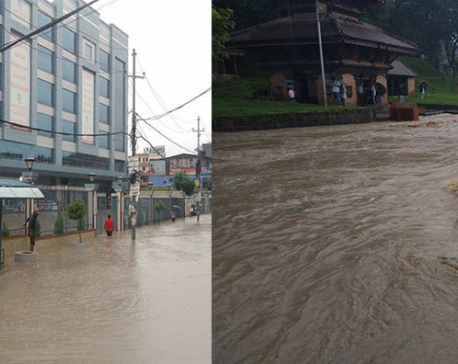
OR

Tejesh Pradhan
The author is a PhD candidate in Economics at American University, specializing in application of micro-econometric models in issues related to development and public policytejeshpradhan@gmail.com
More from Author
The education sector in Nepal is still a black box. The government invests significantly in increasing access and quality of public and private education systems, although the budget share towards education has been declining recently. Public universities and colleges have become a political battlefield rather than productive knowledge enterprise, compelling tens of thousands of students to leave the country every year to pursue their further education.
Partisan politics, bureaucratic challenges and outside interference have rendered institutional governance unable to hold exams and declare results on time, let alone commit to improving education quality and learning environment. Nobody precisely knows which academic practices need to be controlled or encouraged. As the divide between government and private schools is exacerbating, policymakers are essentially swatting flies with a hammer and doing little to remedy the situation.
There are many academic studies of education in Nepal but the focus has been limited to boosting enrolment and reducing attrition. Looking at early signals or the lack of it from students provide early indications of dropping out. Even simple analyses of data including that on teacher effectiveness, classroom interactions or assignment submission patterns could indicate what kind of preventative action is needed. Timely interventions can reduce dropout rates significantly.
Educational institutions and ministries have stockpiled data on grades, attendance, textbook purchase and use, test scores, cafeteria meals, etc. But not much has been done to use that information to enhance learning except to store aggregated data as institutional statistics. Opportunities for better data gathering, dissemination and analysis are constantly overlooked.
As business intelligence acts as the decision foundation in the corporate sector, learning analytics can be a fundamental tool on which reforms are based to inform change in education. Evidence-based understanding of inputs and outputs of learner success is the key to any kind of education reform.
When students, teachers and administrators have the information to make decisions, students excel. Accurate measures of each student’s performance and progress can help identify which students need extra support and why they are lagging behind. Data can be useful in designing personalized learning in and outside the classroom environment, taking into account students’ unique interests and prior abilities. Using in-process evaluation, learning analytics could help create adaptive and competency-based course contents suitable to the education needs of individual learners. Identifying how successful learners work will help schools encourage similar habits and best practices to improve overall student performance. With the knowledge of what works, schools can decide on what resources to spend to improve student outcomes and satisfaction.
What data science can’t do, however, is capture the softer aspects of learning, such as encouragement from class teacher, intrinsic motivation, students’ social interactions outside the classroom, etc. Considering this as a caveat, it is imperative to understand the role of learning analytics in providing structure for accountability, self-evaluation and improvement of educational institutions in Nepal.
Data needs
Well-informed reforms require right information at the right time to make important decisions. Institutions need to be clear about what students must achieve and have the data to foresee that they are on the track to success. Various types of data on students, teachers, learning processes and education institutions can come together to paint a full picture necessary to support the education goals of students and educators.
Student data consists of academic information such as prior school performance, grade level, and courses enrolled. More importantly, scores from assignments, quizzes and exams in various subjects provide the basis for measuring performance and progress. Standard measures include scores in math, science and written and verbal English. It is also of interest to keep performance records of close peers in academic and social networks of students.
Data on use of cafeteria meals/nutrition levels as well as individual’s physical and emotional health status; class attendance, disciplinary actions and extra-curricular involvements/leadership abilities; and demographic information on age, race, gender, economic status as well as parental education levels and socioeconomic background can be equally indicative of children’s learning outcomes.
Teacher performance measures like absence rates, competency and education level attained, previous professional experience, and student evaluations are vital. So is classroom data on size and composition, physical environment, and types of accessible learning resources.
In addition to student and teacher abilities, teaching and learning processes influence learning outcomes. Lesson plans, teaching methods (interactive or instructional/use of PowerPoint or white boards, etc.), frequency and difficulty level of assessments, methods of assessments (e.g. multiple choice or essay questions), regular feedbacks from teachers and student evaluation of the course can provide valuable insights on why or why not students are performing well.
On a broader level, school data, such as on attrition, completion and graduation rates, educational and non-educational HR and infrastructure expenditures, availability of social and psychological student support systems and parent surveys can provide important inputs as to how educational institutions can create a better overall learning environment for its students.
Future Prospects
Not too far from meeting the Sustainable Development Goals for education, quality remains an elusive pursuit in Nepal and across the majority of developing countries. Vast amount of intellectual and policy effort is being spent internationally to pinpoint how education systems can be reformed to provide better learning for all. Researchers have left no stones unturned in measuring the effectiveness of wide varieties of policy action— the impacts of pedagogical interventions, introduction of technology and computers in classrooms, incentivized hiring of teachers and even availability of student desks have been documented in great detail.
From the perspective of a policymaker, it is a matter of testing and adopting solutions that are most suitable to the Nepali political economy of education. But to do that, evidence-based planning and implementation are quintessential ingredients.
The author is a PhD candidate in Economics at American University, specializing in application of
micro-econometric models in issues related to development and public policy
You May Like This

FLOOD ALERT: Rain in the forecast, floods and landslides affect lives across the country (WHAT’S HAPPENED WHERE?)
KATHMANDU, July 12: Rain is the forecast throughout the country, according to an alert published by the Department of Hydrology... Read More...

Missing French woman found dead
KATHMANDU, Aug 18: District Police Syangja on Thursday recovered the dead body of a French woman, who had gone missing... Read More...







Just In
- Health ministry to conduct ‘search and vaccinate’ campaign on May 13
- Indian customs releases trucks carrying Nepali tea, halted across Kakarbhitta
- Silent period for by-election to begin from midnight
- SC issues short-term interim order to govt and TU not to take immediate action against TU legal advisor Khanal
- National consultation workshop advocates to scale up nutrition smart community in Nepal
- Patan High Court issues short-term interim order to halt selection process of NTB’s CEO
- NEPSE inches up 0.15 points; daily turnover increases to Rs 2.53 billion
- Bagmati Govt mandates tri-lingual signboards in offices











Leave A Comment